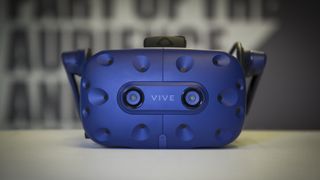Why you can trust TechRadar
HTC Vive Pro: game library
When the HTC Vive first came out on April 5 2016, all we had wanted was a game like Skyrim to play through on the trailblazing headset. While we didn’t get it at the time – and were instead treated to such wonders as Water Bears VR – here we are, a mere two years later, and we have exactly what we wanted.
To that end, one of the biggest improvements for the platform over the last two years has been to the Vive’s library of games. Currently that library includes the aforementioned The Elder Scrolls V: Skyrim VR and Fallout 4 VR, alongside Bethesda’s other hit, DOOM VFR.

Each of these titles offer massive worlds to explore, tons of dungeons, vaults and satanic science labs to comb through and hundreds of enemies to encounter. They’re easily some of the best games on the platform… even though two of the three are ports of console games that came out more than years ago.
We spent the majority of our time with the headset testing these games specifically – and although they’re among our current favorites for the headset, they’re not the only ones worth calling attention to. If you’re looking for something a bit more manageable than a massive open world, there’s the rock-solid rhythm defense game Audio Shield, as well as the silly but enjoyable Job Simulator.
If you’ve got the tolerance for motion, Sprint Vector is a futuristic racing game that’s a strange cross between cross-country skiing and wingsuit gliding, while Arizona Sunshine adds a bit of humor to a post-apocalyptic world brimming with the undead.

SUPERHOT VR flips traditional shooting games on its head with its ‘enemies only move if you move’ mechanic, and The Mage’s Tale adds a bit of whimsy to the Steam collection of anyone with a younger, up-and-coming VR enthusiast in their home.
And, should all else fail, you can always return to the comfortable, reassuring world of Valve’s The Lab, which has a half-dozen mini games, each of which is more fun than almost any other full VR game on the market right now.
The games mentioned above represent a very small sliver of the HTC Vive’s library – and that's to say nothing of the titles on HTC’s Viveport subscription service that offers gamers five new titles every month to add to their collection.
Where exactly are all these games coming from? It might surprise you that new releases are coming out nearly as fast as they are for the more traditional platforms like the Xbox One, PS4 and Nintendo Switch as they are for the VR platforms. And while the majority of them aren’t quite as full featured or as well-designed as their console counterparts, VR has definitely gained traction with developers eager to test out their game creation skills in the new medium – which means really good, system-selling games are only a matter of time.
But that last point is something we should focus on for a second. The importance of system-selling software can’t be understated. It’s what helped Nintendo sell over 10 million units of the Nintendo Switch in its first year, and is the primary reason the PlayStation 4 seems to be outselling the Xbox two-to-one. Without them, platforms just aren’t that appealing.
Two years into its life, we’ve yet to see a system seller for the HTC Vive. Yes, all of the games we mentioned earlier come very close to that golden standard, but none of them are what we’d consider the Mario 64 or The Legend of Zelda: Breath of the Wild of VR. There’s just not a game on HTC Vive (or the Oculus Rift for that matter) that has that kind of clout yet.
As we’ve said all along, this is something that will likely change in the near future. Both HTC and Oculus have sunk major budgets into the dev community to encourage developers to bring their next hit game to VR. Someday we’ll likely have a GoldenEye of VR, or a Final Fantasy VII or a Halo. But right now, we don’t.
The last important point we’ll make here is that all these games – Skyrim, Fallout, DOOM, Arizona Sunshine, Sprint Vector, and son on – aren't exclusive to the HTC Vive Pro. Any and everything we’ve mentioned here is playable on the original Vive and the Oculus Rift, if at a slightly lower resolution.
That doesn’t mean that these games can’t look better on the HTC Vive Pro than they do on the other systems – they do – but it does mean that you can get them elsewhere without shelling out $800, £800 or around AU$1,045 for them.

HTC Vive Pro: extended use
Before we close out the review, we’d like to offer a word of warning – just as we did two years ago in our original HTC Vive, Oculus Rift and PlayStation VR reviews.
The warning is that you might not be capable of extended play sessions in VR – and there’s a very good chance that you’ll have to build your tolerance to the headset one 10-minute play session at a time for the first few weeks.
We mention this warning for a few reasons. The first is that, with any investment you make, you should want to know how much time you’re going to get out of it. The second is that, VR can actually cause you to feel sick – either with a pretty severe headache or an upset stomach – after using it for more than an hour or two.
To that end, game responsibly. Take breaks in between games. Make sure you aren’t pushing yourself too hard, just to make it to that next objective. It’s not worth the potential hours of headaches that will come afterward. VR is similar to every other form of media – enjoy it in moderation, never excess.
HTC Vive Pro: verdict
While resolution will surely win the lion’s share of the recognition, HTC has made a number of fantastic design choices on the HTC Vive Pro that rival the resolution in terms of importance.
To narrow those down to just a few points, the headset is more comfortable than it ever has been, it sounds better (most of the time) and it blocks out light. Oh, and yeah, games look better on it, too.
But are these design improvements worth the HTC Vive Pro’s rather costly entry ticket? Are they worth that cost even after you’ve figured in some of the system’s shortcomings like the lack of a AAA game, the setup and sound issues and jitteriness with less-than-pristine hardware? Finally, does it make sense to buy to an HTC Vive Pro when the original Vive has hit an all-time low sticker price of $499 or £499 (about AU$615)?
In our opinion, given the games that are out there and the system’s half-step up in performance from the original headset, the answer is probably not. It’s still a great headset – and one of the best damn headsets on the market – but just not the best one for the money, effort and parts you’ll need to put into it.
Current page: HTC Vive Pro: Game Library, Extended Use and Verdict
Prev Page HTC Vive Pro: Setup, Performance and Recommended SpecsNick Pino is Managing Editor, TV and AV for TechRadar's sister site, Tom's Guide. Previously, he was the Senior Editor of Home Entertainment at TechRadar, covering TVs, headphones, speakers, video games, VR and streaming devices. He's also written for GamesRadar+, Official Xbox Magazine, PC Gamer and other outlets over the last decade, and he has a degree in computer science he's not using if anyone wants it.


